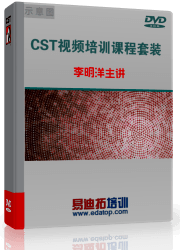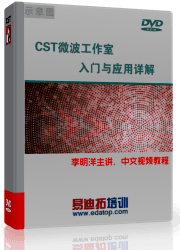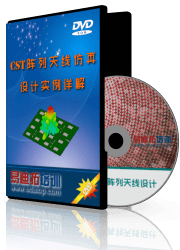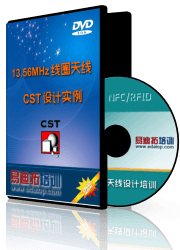- 易迪拓培训,专注于微波、射频、天线设计工程师的培养
CST2013 MWS Examples: Slow Wave
Hexahedral mesh:
Tetrahedral mesh:

General Description
This example demonstrates an eigenmode calculation using periodic boundaries in z-direction.
The phase shift of the periodic boundary is defined as a parameter which is swept from 5 degrees to 175 degrees with a step size of ten degrees.
A userdefined parameter sweep watch monitors the sweep process, thereby creating group velocity, phase velocity and dispersion diagrams, as well as powerflow and interaction impedance (= Pierce Impedance).
Units and Background Material
The units are changed to millimeters, gigahertz and nanoseconds, and the background material is defined as perfectly conducting material.
Structure Generation
The construction of the helix starts with the definition of a solid box, whose width is set equal to the wall thickness of the helix. The front face and the 'inner' edge are picked and the edge is shifted towards the center of the helix by the inner radius of the helix in order to create a solid of rotation, which is defined by the number of turns (the angle equals two turns times 360 degrees) and the height of the helix (the height equals two turns times pitch).
The local coordinate system is translated to the center axis of the helix. A cylinder surrounding the helix is added to the dielectric layer "apbn" together with a brick. Both solids are combined using the 'Boolean intersect' command. The resulting shape is rotated, thereby creating three evenly spaced copies (at an angle of 120 degrees between the copies).
Afterwards, a PEC box is defined. A solid PEC cylinder and a copy made of vacuum are created in the place of the previous cylinder. The PEC cylinder is used to cut a cylindrical hole into the box, and the three inlets are inserted into the air cylinder.
With the local coordinate system aligned to the top face of the former PEC box, the helix can be sliced by the uv-plane. The upper part is removed.
As an alternative, a box of arbitrary extent may be defined below the structure, added to a 'normal' layer and inserted into the remaining solids, thereby trimming these objects. The box itself is deleted.
Since the helix is not well represented by the default mesh, maximum mesh step widths are defined for this solid.
The automesh option is disabled for the two inlets which are not parallel to the coordinate axes.
Mesh Settings
Curved element order property for the tetrahedral mesh is set to 2.
Frequency Range and Boundary Conditions
The frequency range starts at DC and ends at 10 GHz. The boundary conditions are set to "electric" except for the two boundary conditions in z-direction, which are defined as "periodic" in order to model an infinite extent of the helix. A parameter "phase" is assigned to the periodic boundary, so that the phase shift can be used in a parameter sweep.
Solver Setup
Whenever the eigenmode solver is started, a specific number of the lowest eigenmode frequencies of the structure are calculated. With periodic boundaries and a non-zero phase shift, those eigenmodes are traveling waves. Since only the fundamental mode is of interest, the number of modes is reduced to one. The JDM eigenmode solver is chosen, which is faster for the given example, for the hexahedral mesh.
After the parameter sweep has been selected from the eigenmode solver's dialog, a new sequence is added, and the parameter "phase" is chosen to be swept from 5 to 175 degrees in 18 steps. A userdefined watch is already available and may serve as a template for building custom watches. Please select Edit to view or modify the source code.
Post Processing
The userdefined parameter sweep watch adds the group velocity, phase velocity and dispersion plots of the first mode to the navigation tree in the folder 1D Results. Also, the power flow and Pierce Impedance can be seen in the folder 1D Results.
CST微波工作室培训课程套装,专家讲解,视频教学,帮助您快速学习掌握CST设计应用
上一篇:CST2013 MWS Examples: Three Line Taper (Single-Ended)
下一篇:CST2013 MWS Examples: Two Slots In Plane Antenna
CST濞戞搩鍘介弸鍐喆閸℃侗鏆ラ柛鈺冾攰椤斿嫰寮▎鎴旀煠 | More...
 最全面、最专业的CST微波工作室视频培训课程,可以帮助您从零开始,全面系统学习CST的设计应用【More..】
最全面、最专业的CST微波工作室视频培训课程,可以帮助您从零开始,全面系统学习CST的设计应用【More..】
频道总排行
- Rectangular Waveguide Tutorial
- FSS: Simulation of Resonator
- CST2013 MWS Examples: Thermal C
- Dipole Antenna Array - CST201
- CST MWS Examples - CST2013 M
- Microstrip Radial Stub - CST2
- Dielectric Resonator Antenna -
- Interdigital Capacitor - CST20
- CST2013 MWS Examples: Biological
- Lossy Loaded Waveguide - CST2










